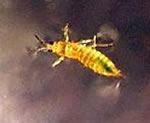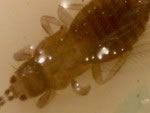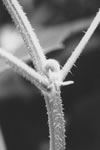I hate to bring bad newz but thrips arent as easy to deal with as some folks here will have you believe. And yes I agree it looks like thrips is whats ailing ya plants. Some earlier said oh just use some
spinosad foliar and rest east. NOT!!! thrips if left uncontrolled will decimate your crop. They will literally suck the life out of your garden.
Foliar pesticides have effect on the flyers and grubs in the soil that can be dealt with with soil drenches. But here is where it gets interesting, thrips lay their eggs not on the leaf surface like a lot of pests, but they actually pierce the leaf tissue and lay them fokkers inside the leaf. Whats up with that you say???? Well what that does is it makes it's eggs almost impervious to any foliar application you can throw at them. The best way to deal with thrips is bio control. Here is some information you might find helpful. Suit up, buckle up cause your in for a helluva ride eradicating these fokkers from your grow.
Personally given the fact that there are so many pests out there that can screw with cannabis I think not enough attention is given to this little bastard because it is one of the tougher pests to deal with due to where they lay their eggs. Good luck with your battle, and use the predators that are suggested to control them. I am providing a link as well as it is a great resource and will help you develop a good IPM. They also call out what predators work best for thrips.
Thrips Pests
Some Background

Thrips are members of the order Thysanoptera. There are over 4500 species throughout the world, with several known to invade greenhouses and interiorscapes — especially greenhouses with floral crops. A thrips (yes, thrips, with an “s” is the singular and plural versions of this pest’s name) is not only known for the direct plant damage it causes, but also for the serious plant diseases it vectors.
How They Become a Problem

Thrips invade greenhouses in myriad ways. First of all they reside in structures year ’round, hiding in the smallest of places. They also enter greenhouses on plants, of course, which highlights, again, the need for serious plant inspections before plants are accepted and allowed to take up space in your greenhouse. The adult thrips are also flyers. Their wings are more like feathers having fringes of hairs, or setae, and are very difficult to see-especially since they keep them close to their yellowish to dark green to brown-black elongate bodies when not in use. They do, however, function well. Their wings carry them, combined with natural breezes, over great distances.
A Serious Pest

Female thrips can reproduce sexually or asexually without a mate — it is their option.
They lay their eggs in the soft tissue of plants, which is not terribly damaging to the plants, in itself, but it does protect the eggs from just about everything under the sun. That can’t be a good thing. The damage to plants and flowers is caused by the other end of these pests-the feeding end. Thrips have rasping and piercing-sucking mouthparts. They first rasp the cells causing a “wound.” The “wound” oozes plant sap. The thrips then insert their straw-like stylet into the damaged cells and begin to draw the juices. And if that isn’t enough, thrips are famed for their transmission of two horrific plant diseases: impatiens necrotic spot virus (INSV) and tomato spotted-wilt virus (TSWV). We’ll give you information about these plant viruses, so read on. If you don’t want your plants to get these special tospoviruses, don’t let thrips into your facility no matter how loudly they knock. If they do get in, control them as quickly as possible. Feeding damage can pale in comparison to what these viruses can do.

Thrips can lay a number of eggs. Their life cycle can be fairly short, dependent upon the temperature. If it’s cool, it can take over a month’s time from egg to adult; if hot, it can take as little as fourteen days. Needless to say, thrips are more problematic in the hottest months of summer. The various larval stages-of which there are two — and the adult stages are typically well-placed in their host plants. They can often be found deep within the plant’s flowers. Moreover, they will also hide in closed buds making their control, especially with chemicals, difficult at best. Fortunately, some of the biocontrol agents available to thwart them will go in after them and drag ’em out screaming. Many growers who do use chemical pesticides in their effort to control them will suit up during the hottest part of the day. This is when the thrips are most active, often venturing freely all over the plant instead of only hiding within its tight places.
Some Advice

Somewhere between a complete and incomplete metamorphosis, thrips have a unique way of growing up. Two of their stages, the prepupal and pupal stages, at least for some species, are spent in the soil, growing medium and other friable material. In a nutshell, they will fall off the plant and drop to the ground. Good news, with the right tools they can easily be controlled down-under. Right tools like the predatory mite
Stratiolaelaps scimitus. Not all thrips species, mind you, do this but the majority of which growers will be concerned with do. Some common species are flower thrips, echinothrips, greenhouse thrips, onion thrips and, by far the most prevalent, the western flower thrips.
For The Scout
Scouting for thrips should entail a proper regimen, as always. And in this regimen growers can use a considerable variety of tools.
Yellow sticky traps are one such tool. And if you’re using biocontrol agents to treat for or prevent other pests, which may be captured in yellow traps, then blue sticky traps are also very good at trapping thrips. Thrips, especially the larval stages, are, however, more difficult to count on blue traps. A proper scouting regimen will also utilize single plant inspections. For thrips monitoring, use some plants which will bear a steady supply of flowers. These flowers may be tapped or lightly shaken over a white sheet of paper — a drop-cloth, if you will — to facilitate easy detection. Like spraying, this should be done at high noon; but we encourage midday scouting, anyway. You may also lightly blow into open flowers as this will generally lure them out.

One of the best ways to deal with thrips is to practice exclusion using an extremely fine insect screen and to carefully inspect incoming plant material, especially if it’s budding or flowering. Screening sounds pretty straightforward, but it entails planning because the material is so tightly woven, it will significantly reduce airflow. Looser meshed (anti-virus) screens are probably the way to go as they do keep most thrips outside where they belong without such a dramatic airflow reduction.
Using a trap crop is also a great idea for thrips. Blue flowers, like asters, work well. So do many other flowering plants. You may also choose to incorporate plants such as petunias and fava beans. These are especially important as they can be indicative of not only thrips, but the viruses they vector. Symptoms such as leaf spots, brown, oozing patches, necrotic leaves, concentric rings of various colors, and others, can all tell you a story about your local thrips-even if you don’t see the critters themselves. If you see some of the symptoms described, seek the help of a book containing color photos of these diseases on the varieties of plants you’re growing for a side-by-side comparison. Also, and don’t be afraid to do this, seek the assistance of professionals well-versed in identifying these problems. Start with your area university’s cooperative extension office.
Aside from seeking the thrips themselves, or looking for the disease symptoms they can cause, feeding damage may also be revealing. Silvery striations along the leaves are indicative of feeding. They feed on leaves somewhat like the way a person would mow a lawn: back and forth, or round and round, forming a pattern. The silvery patches are actually groups of individual, spent plant cells. Other symptoms of feeding may include deformed leaves, buds and flowers. Some vegetable, such as peppers and cucumbers, and some fruits, may suffer abortion. The last sign is the presence of fecal matter. The feces show themselves as tiny black specks. Please bear in mind, if you see these signs of feeding damage, you have a great deal of these nasty pests — at least locally on the plant(s) on which the symptoms appear. If it is found on a single specimen, which, coincidently, happens to be next to the door, get rid of the plant. Keeping it may spell trouble; and the plant is probably not worth it.
Some Solutions
When thrips, like the ever-popular western flower thrips, become established in your crop their foothold can be tenacious. It is, therefore, very important to locally spray at the very first sign of them — assuming they aren’t actually already resistant to whatever you’re using and you can actually get the spray to them in the first place. However, if you’re using biocontrols, your actions should be preventive and aggressive. It doesn’t have to cost very much money, but it must be preventive and aggressive for the best results! There are several biocontrol agents which are very effective against thrips. Some kill the larval stages, some the prepupal and pupal stages, others the adults. You may want to use them all. Two in particular,
Neoseiulus cucumeris (for the larvae) and
S. scimitus (as previously mentioned, for the in-ground pupal stages), when used in concert, preventively and aggressively, have proven themselves repeatedly — in interiorscapes and greenhouses.











